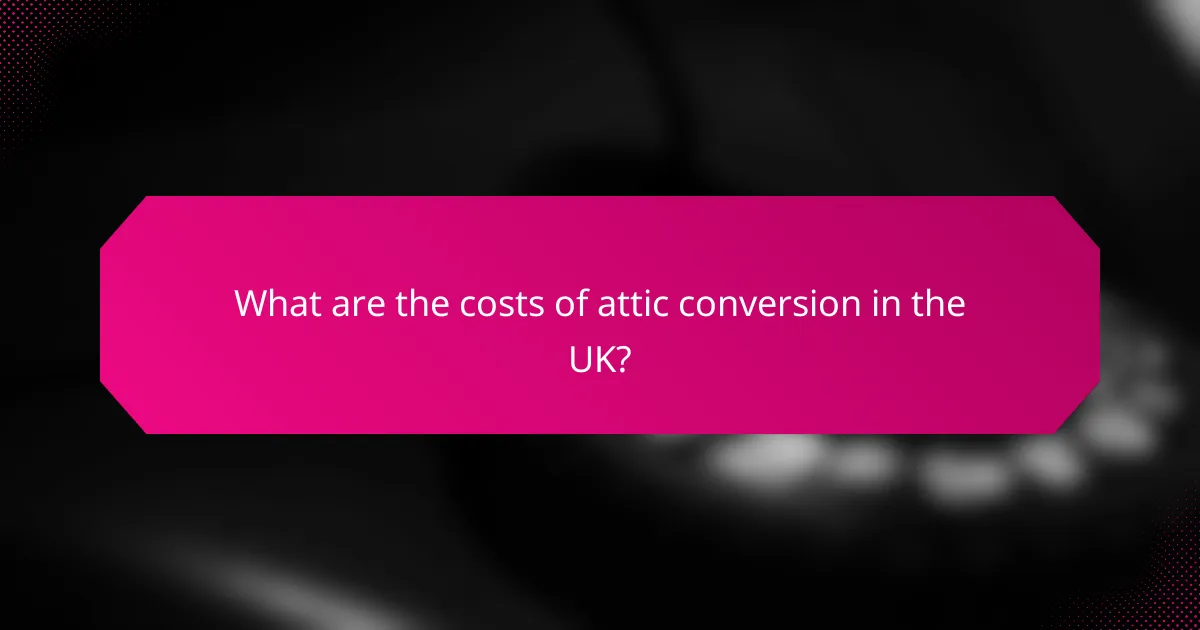Converting your attic can be a valuable investment, with costs typically ranging from £20,000 to £50,000 in the UK. This project not only expands your living space but also significantly boosts your property’s market value. To finance this transformation, homeowners can explore various options such as home equity loans, personal loans, and government grants, each tailored to different financial needs.

What are the costs of attic conversion in the UK?
The costs of attic conversion in the UK typically range from £20,000 to £50,000, depending on various factors. This investment can significantly enhance your property’s value and living space, making it a popular choice for homeowners.
Average cost range
The average cost for an attic conversion in the UK generally falls between £20,000 and £50,000. Basic conversions, such as a simple loft room, may start at the lower end, while more complex projects, including en-suite bathrooms or structural modifications, can reach the higher end of this range.
Homeowners should budget for additional expenses, such as planning permission and building regulations, which can add several thousand pounds to the overall cost. It’s advisable to obtain multiple quotes from contractors to ensure competitive pricing.
Factors affecting costs
Additionally, the location of the property can impact pricing. Conversions in London and the South East tend to be more expensive compared to other regions due to higher labor and material costs. Consideration of insulation, windows, and access points also plays a crucial role in the overall budget.
Cost breakdown by type
Attic conversions can be categorized into several types, each with distinct cost implications. A Velux conversion, which involves installing roof windows, is usually the most affordable option, typically costing between £20,000 and £30,000.
In contrast, a dormer conversion, which adds extra headroom and space, can range from £30,000 to £50,000. Mansard conversions, known for their complex structure and maximum space utilization, may exceed £50,000. Understanding these types can help homeowners choose the best option that fits their budget and needs.

What financing options are available for attic conversions?
Several financing options can help fund your attic conversion, including home equity loans, personal loans, and government grants. Each option has its own benefits and considerations, making it essential to evaluate what best suits your financial situation.
Home equity loans
Home equity loans allow you to borrow against the equity in your home, typically offering lower interest rates compared to unsecured loans. This option is ideal if you have significant equity built up, as it can provide substantial funding for your attic conversion project.
When considering a home equity loan, be aware of the potential risks, such as putting your home at stake if you fail to repay. Generally, lenders may allow you to borrow up to 80% of your home’s equity, but this can vary based on your creditworthiness and lender policies.
Personal loans
Personal loans are unsecured loans that can be used for various purposes, including home improvements like attic conversions. These loans typically have higher interest rates than home equity loans, but they do not require collateral, making them a viable option for those without significant home equity.
When applying for a personal loan, consider your credit score, as it will influence the interest rate and terms you receive. Loan amounts can range from a few thousand to tens of thousands of dollars, depending on the lender and your financial profile.
Government grants and schemes
Government grants and schemes may be available to assist with the costs of attic conversions, especially if the project improves energy efficiency or provides affordable housing. These programs can vary widely by location, so it’s essential to research what is available in your area.
To access these funds, you may need to meet specific eligibility criteria and submit an application. Check with local housing authorities or government websites for detailed information on available grants and how to apply for them.

How does an attic conversion increase property value?
An attic conversion can significantly enhance property value by adding usable living space, which is highly sought after in real estate markets. This transformation not only increases square footage but also improves the overall appeal of the home, making it more attractive to potential buyers.
Percentage increase in value
The value added by an attic conversion typically ranges from 10% to 20% of the property’s current market value. This percentage can vary based on factors such as location, quality of the conversion, and local market conditions. In some high-demand areas, the increase could be even more substantial.
Market demand for converted spaces
Impact on property appeal
An attic conversion enhances a property’s appeal by showcasing innovative use of space and modern design. Well-executed conversions can create bright, inviting rooms that attract buyers. Additionally, a stylish attic can differentiate a home from others on the market, making it more memorable and desirable.

What are the prerequisites for an attic conversion?
Before starting an attic conversion, it’s essential to understand the necessary prerequisites, which include obtaining planning permission and ensuring compliance with building regulations. These steps help ensure that your project is legal, safe, and structurally sound.
Planning permission requirements
In many cases, attic conversions require planning permission, especially if the project involves significant structural changes or increases the building’s height. Local regulations vary, so it’s crucial to check with your local planning authority to determine if your project needs approval.
Some common exemptions may apply, such as converting an attic into a living space without altering the roofline or external appearance. However, if your property is in a conservation area or is a listed building, stricter rules may apply.
Building regulations compliance
Building regulations ensure that any attic conversion meets safety and structural standards. Compliance typically covers aspects such as fire safety, insulation, and structural integrity. You will need to submit detailed plans to your local building control department for approval.
Key areas to focus on include ensuring adequate headroom, proper ventilation, and safe access via stairs. Engaging a qualified architect or builder can help navigate these regulations effectively and avoid costly mistakes.

What are the common design options for attic conversions?
Common design options for attic conversions include creating functional spaces such as loft bedrooms, home offices, and playrooms. Each option has unique considerations regarding layout, insulation, and local building regulations.
Loft bedrooms
Loft bedrooms are a popular choice for attic conversions, offering a cozy and private space. When designing a loft bedroom, consider the ceiling height, as it should ideally be at least 2.4 meters to ensure comfort. Additionally, incorporating skylights can enhance natural light and ventilation.
Budgeting for a loft bedroom typically ranges from a few thousand to tens of thousands of dollars, depending on the level of finish and structural changes required. Ensure compliance with local building codes, which may dictate safety features like egress windows.
Home offices
Converting an attic into a home office can create a quiet and dedicated workspace away from household distractions. When planning this space, focus on adequate lighting, electrical outlets, and internet connectivity to support your work needs.
Costs for a home office conversion can vary widely, often falling between several thousand and over twenty thousand dollars. Consider soundproofing options if noise is a concern, and ensure that the space is ergonomically designed for comfort during long working hours.
Playrooms
Attic playrooms can provide children with a fun and safe area for play, away from the main living spaces. When designing a playroom, prioritize safety features such as soft flooring and secure storage for toys to minimize hazards.
Budgeting for a playroom conversion generally ranges from a few thousand to around fifteen thousand dollars, depending on the complexity of the design and materials used. Incorporating bright colors and creative storage solutions can enhance the play experience while keeping the space organized.

What are the emerging trends in attic conversions?
Emerging trends in attic conversions focus on maximizing space efficiency and sustainability. Homeowners are increasingly opting for eco-friendly materials and smart home technologies while transforming their attics into functional living areas.
Maximizing Space Efficiency
Maximizing space efficiency in attic conversions involves strategic design choices that enhance usability. Popular options include built-in storage solutions, open floor plans, and multi-functional furniture. These elements help create a comfortable living area without clutter.
Consider using vertical space by incorporating shelving or lofted beds, which can free up floor space for other uses. This approach is especially beneficial in smaller attics where every square foot counts.
Sustainable Materials and Practices
Homeowners are increasingly prioritizing sustainable materials in their attic conversions. This includes using reclaimed wood, energy-efficient insulation, and low-VOC paints to minimize environmental impact. Such choices not only benefit the planet but can also improve indoor air quality.
Incorporating energy-efficient windows and solar panels can further enhance sustainability, leading to long-term savings on energy bills. These investments often yield a higher return on investment when it comes time to sell the home.
Integration of Smart Home Technologies
Integrating smart home technologies into attic conversions is becoming a key trend. Homeowners are installing smart thermostats, lighting systems, and security features that can be controlled remotely. This not only adds convenience but also increases the appeal of the space.
Consider incorporating smart features that enhance energy efficiency, such as automated blinds or smart lighting that adjusts based on occupancy. These technologies can make the attic more functional and attractive to potential buyers.
